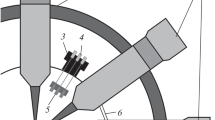Abstract
In wide-gap materials used in nuclear detectors, the polarization effect is typically observed when the concentration of radiation-induced defects is high. An emf arising in the detector is associated with long-term trapping of charge carries by deep radiation-induced levels (centers). The polarization kinetics and the polarization field strength are determined experimentally. The trapping efficiency can be controlled by varying the temperature, and a tradeoff can be reached at an “optimal” temperature between the generation current and the position of the deepest level, which has a negligible effect on charge losses via trapping. It is found that the ratio between the depth of this level and the bandgap is about 1/3 irrespective of the material but the optimal temperature is material-specific.
Similar content being viewed by others
References
V. L. Vinetskii and G. A. Kholodar’, Statistical Interaction of Electrons and Defects in Semiconductors (Naukova Dumka, Kiev, 1969) [in Russian].
A. A. Lebedev, A. I. Vienger, V. V. Kozlovski, D. V. Davydov, N. S. Savkina, and A. M. Strelchuk, J. Appl. Phys. 88, 6265 (2000).
A. Castaldini, A. Cavallini, L. Rigutti, F. Nava, S. Ferrero, and F. Giorgis, J. Appl. Phys. 98, 053706 (2005).
A. M. Ivanov, A. A. Lebedev, and N. B. Strokan, Semiconductors 40, 1224 (2006).
A. M. Ivanov, N. B. Strokan, E. V. Bogdanova, and A. A. Lebedev, Semiconductors 41, 115 (2007).
A. M. Ivanov, N. B. Strokan, and A. A. Lebedev, Semiconductors 42, 1117 (2008).
A. M. Ivanov, N. B. Strokan, and A. A. Lebedev, Nucl. Instrum. Methods Phys. Res. A 597, 203 (2008).
K. Hecht, Z. Physik. 77, 235 (1932).
A. M. Ivanov, A. V. Sadokhin, N. B. Strokan, and A. A. Lebedev, Semiconductors 45, 1369 (2011).
A. Castaldini, A. Cavallini, F. Fabbri, F. Nava, P. Errani, and V. Cindro, in Proceedings of the 8th Workshop, Prague, 2006. http://rd50.web.cern.ch/rd50/
P. A. Ivanov, M. E. Levinshtein, J. W. Palmour, S. L. Rumyantsev, and R. Singh, Semicond. Sci. Technol. 15, 908 (2000).
D. Katsunori and K. Tsunenobu, J. Appl. Phys. 100, 113728 (2006).
V. A. Tikhomirova, O. P. Fedoseeva, and G. F. Kholuyanov, At. Energ. 34, 122 (1973).
Rainer S. Wallny, Nucl. Instrum. Methods Phys. Res. A 582, 824 (2007).
M. Cristinziani, Nucl. Instrum. Methods Phys. Res. A 623, 174 (2010).
Author information
Authors and Affiliations
Corresponding author
Additional information
Original Russian Text © A.M. Ivanov, N.B. Strokan, A.A. Lebedev, 2012, published in Zhurnal Tekhnicheskoi Fiziki, 2012, Vol. 82, No. 4, pp. 137–141.
Rights and permissions
About this article
Cite this article
Ivanov, A.M., Strokan, N.B. & Lebedev, A.A. Radiation resistance of wide-gap materials as exemplified by SiC nuclear radiation detectors. Tech. Phys. 57, 556–560 (2012). https://doi.org/10.1134/S1063784212040111
Received:
Published:
Issue Date:
DOI: https://doi.org/10.1134/S1063784212040111




